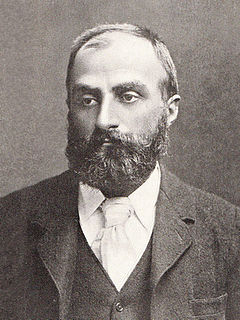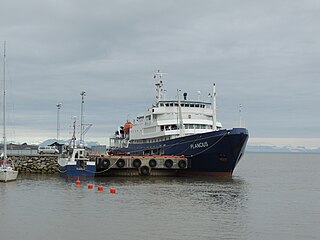
William Speirs Bruce was a British naturalist, polar scientist and oceanographer who organized and led the Scottish National Antarctic Expedition to the South Orkney Islands and the Weddell Sea. Among other achievements, the expedition established the first permanent weather station in Antarctica. Bruce later founded the Scottish Oceanographical Laboratory in Edinburgh, but his plans for a transcontinental Antarctic march via the South Pole were abandoned because of lack of public and financial support.

The Norwegian Polar Institute is Norway's central governmental institution for scientific research, mapping and environmental monitoring in the Arctic and the Antarctic. The NPI is a directorate under Norway's Ministry of Climate and Environment. The institute advises Norwegian authorities on matters concerning polar environmental management and is the official environmental management body for Norwegian activities in Antarctica.

Edgeøya, occasionally anglicised as Edge Island, is a Norwegian island located in southeast of the Svalbard archipelago; with an area of 5,073 square kilometres (1,960 sq mi), it is the third-largest island in this archipelago. An Arctic island, it forms part of the Søraust-Svalbard Nature Reserve, home to polar bears and reindeer. An ice field covers its eastern side. The island takes its name from Thomas Edge, an English merchant and whaler. It is seldom visited today and development of tourist facilities is forbidden by law because of its nature reserve status.
MS Expedition is an expedition cruise ship owned and operated by the Canada-based G Adventures. She was built as a car/passenger ferry in 1972 by Helsingør Skibsværft og Maskinbyggeri A/S, Helsingør, Denmark as Kattegat for Jydsk Færgefart A/S. Subsequently, she sailed under the names nf Tiger for P&O Normandy Ferries, Tiger for Townsend Thoresen and Ålandsfärjan for Viking Line, prior to conversion into a cruise ship in 2008. The MS Expedition has the IMO number 7211074 and is ice-strengthened, having an ice class of 1B. There are two higher classes, being 1A Super and 1A.

Polar Star Expeditions was a specialty adventure cruise company owned by Karlsen Shipping Company Ltd. out of Halifax, Nova Scotia, Canada. In 2001, Polar Star began operating a single expedition cruise ship, MV Polar Star, a 87-metre (284 ft) converted Swedish icebreaker with 105 berths. The company conducted cruises mainly in the northern and southern polar and sub-polar regions. Polar Star Expeditions did not have an easy time of it. In 2010, its only vessel lost one of its engines and had to operate part of that season on just one. Then in January 2011, the vessel suffered serious grounding damage in the Antarctic, which led to the failure of the parent company.
Orion Expedition Cruises (OEC) is a former Australian-based luxury expedition cruise line that operated the German-built 103 m, 4000 gross tonne MV Orion in Australasian and Antarctic waters.

National Geographic Orion is operated by New York City-based Lindblad Expeditions - National Geographic.

MV Ortelius is an ice-strengthened vessel currently employed for expedition-style polar cruises by owner and operator Oceanwide Expeditions. She was originally named Marina Svetaeva and was built in Gdynia, Poland, in 1989 as a special-purpose vessel for the LLC RN-Sakhalinmorneftegaz.

Quark Expeditions is an expedition travel company. The company offers Polar Region expeditions aboard purpose-built expedition ships and icebreakers.

Belgica was a barque-rigged steamship that was built in 1884 by Christian Brinch Jørgensen at Svelvik, Norway as the whaler Patria. In 1896, she was purchased by Adrien de Gerlache for conversion to a research ship, taking part in the Belgian Antarctic Expedition of 1897–1901, becoming the first ship to overwinter in the Antarctic. In 1902, she was sold to Philippe, Duke of Orléans and used on expeditions to the Arctic in 1905 and from 1907 to 1909.

Antarctic was a Swedish steamship built in Drammen, Norway, in 1871. She was used on several research expeditions to the Arctic region and to Antarctica from 1898 to 1903. In 1895 the first confirmed landing on the mainland of Antarctica was made from this ship.

MV Plancius, formerly HNLMS Tydeman (A906), is a renovated oceanographic research vessel of the Royal Netherlands Navy now employed as a polar expedition cruise vessel by owner and operator Oceanwide Expeditions. She was commissioned into the Royal Netherlands Navy on 10 November 1976, and served until 2004, before being renovated for commercial use. The vessel was used for both military and civilian research and had a fracture zone named after it.
Students on Ice Foundation is a Canadian charitable organisation that leads educational expeditions to the Arctic and Antarctic for international high school and university students. Its mandate is to provide youth, educators and scientists from around the world with learning and teaching opportunities in the polar regions, with the goal of fostering an understanding of, and commitment to building a more sustainable future.

Piloto Pardo was a Chilean Navy auxiliary ship from 1959 until 1997. After decommissioning she was converted to an Antarctic expedition cruise ship and operated as such until 2012 under the name MV Antarctic Dream.
The Association of Arctic Expedition Cruise Operators (AECO) is a voluntary cooperative organization of cruise lines largely working in the European arctic, including Greenland and Svalbard. AECO establishes guidelines for its members that cover passenger safety, environmental protection issues and ethical interactions with indigenous populations.

Rembrandt van Rijn is a Vanuatu-flagged three-masted schooner currently employed for Arctic cruises by owner and operator Oceanwide Expeditions. She was built in 1924 as a fishing lugger and has served as a coaster and schooner under the flags of the Netherlands, Germany, Denmark, and Panama. The ship has been lengthened three times, fitted with four different engines, and has had a change of IMO number during her career on the seas.

S/V Noorderlicht is a two-masted schooner built in 1910 as a light sailing vessel for the German Navy. Since the 1990s, she has served as one of the expedition cruise vessels for Oceanwide Expeditions, sailing to some of the most remote locations in the Arctic, particularly the Norwegian archipelago of Svalbard.
Poseidon Expeditions was founded in 1999 as a tour operator specializing in expedition cruises to the North Pole and the Russian High Arctic aboard icebreakers and ice-strengthened ships. The company offers polar expedition cruises to the Arctic, Antarctica and the North Pole.

MV Norsel was a Norwegian sealing ship home ported in Tromsø. Launched during the final weeks of the Second World War as Lyngdalsfjord and only completed in late 1949, the ship sailed in both Arctic and Antarctic waters for more than 53 years until shipwrecking off the coast of Norway in 1992.
Le Commandant Charcot is an icebreaking cruise ship operated by the French shipping company Compagnie du Ponant. Named after the French polar scientist Jean-Baptiste Charcot, the vessel was built at Vard Tulcea shipyard in Romania, from where she was moved to Søviknes for final outfitting and delivery in 2021.
















